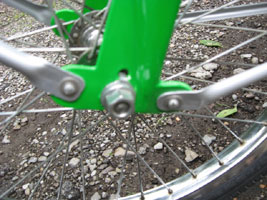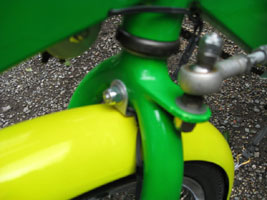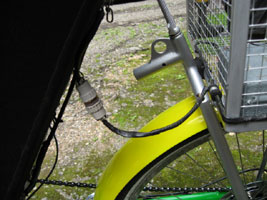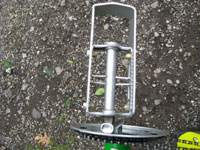
Bill McKay's Latest Recumbent Project - 2/2009
Bill has completed his most recent and perhaps last recumbent... He says he wants to spend more time riding, rather than building. Here is what he had to say about this new recumbent:
"I wanted this one to be a rider from the start with no trial and error, so I sent for a set of Bentech plans and used their dimensions for wheel base, seat height, BB location and trail. Then I let my imagination run wild. I finished it last spring (08) and liked the ride so well, that I rode it last summer half in primer and half bare metal. Over the winter I made a few modifications and painted it. It has a lot of features from my other bents, however one new addition is a sound system. I used a laptop speaker amplifier from Radio Shack and fed it with a Walkman radio / cassette player."
|
|
||
 |
 |
 |
I asked Bill for some more details on this bike and here is his reply:
"- USS: I really like under seat steering. I got into bents because
my diamond bike gave me sore wrists, back, and butt. It didn't seem that
having my arms out in front of me was going to solve the wrist problem.
I rode two bents with OSS and after two or three miles I could feel my
arms getting tired. The problem with USS is that at first it feels less
safe than OSS, But it doesn't take long to get over that feeling. When
someone says ," You look so comfortable riding that bike." I tell them
it's like sitting in my lazy boy chair watching TV. Be sure the handle
bars are positioned where your relaxed hands hang down.
- Mast: The mast was first installed to accommodate the mirror because I
could not figure out a place to install it on a USS bent. I tried an eye
glass clip on and hated it. The flag, speedometer, and push handle
holder were later additions. It does not obstruct my vision, in fact I
don't even notice it any more. It does vibrate a bit and I went from 1/2
to 3/4 EMT as well as a little brace on this bent because of it. The
vibration does not hinder the use of the mirror. One other plus is it
makes balancing and holding the bent while getting on and off much
easier.
- Racks: The luggage racks, one for tools and one for cold drinks, are
old style rubber maid coolers that I picked up at thrift stores and flea
markets. I actually have eight of them, painted to match my different
bents. When the coolers are removed, the holders fold up vertical for
transport
- Speed: Last summer I rode it as a 15 speed, but came to realize that
all my riding is on rails to trails and that I rode 99% of the time in
the same gear. Even starting out because I would forget to shift down
when I stopped. So I removed the front shifter and small front sprocket.
Now I'll ride on the big front sprocket and if I need a lower gear I'll
just stop and move the chain by hand. I use paraphene wax on my chain so
dirt is no problem. So the answer is the bent is a 5 speed, However if I
was going to ride on the road I would keep the 15 speeds."
|
Here are some photos Bill took and his descriptions of the bike's design and construction details |
|||

|
|
||
 |
View of mirror post mount. Tab on the front of the BB is for hanging the bike to work on it. |
||
 |
View showing the fender mount tabs on the front fork. |
||
 |
View showing the steering set up on the front fork. |
||
 |
View of right brake lever with brake light switch. The sonalert horn button is located in the end of the grip. |
||
 |
View of chain idler sprockets. Both are made from plastic in line skate wheels turned down until the small sprocket from a rear wheel sprocket assembly can be forcefully screwed onto it. The outside sprocket uses both wheel bearings because it carries the drive chain while the inside, chain return, sprocket has one bearing. The divider plates keep the chain from jumping off the sprocket which it did occasionally while shifting. |
||
 |
View of the left hand grip showing the modified shift lever and brake light switch. The regular shifter was awkward to operate on the USS handle bar so I modified it fit on the end and stick straight out like some of the high end bikes. |
||
 |
View of extended kick stand with bottom plate added for parking on soft areas. |
||
 |
Both brake calipers on the rear wheel. Notice
that the shoe slots are lengthen and adjusting stop screws
with captive nuts are located in them. This allows the brake
pads to be adjusted close to the rim resulting in very
little brake lever movement to achieve full braking power.
In addition the brakes never drag on the rim. |
||
 |
This is the rear wheel retaining washer ( left side ). This tear drop washer has a pin that fits into the frame and keeps the axel in place even if the nut is loose or removed. The second picture below shows a similar arrangement on the right side. |
||
 |
View of the steering rod connection to the handle bar. |
||
 |
This is the reworked derailleur. Notice that the slot has been welded shut leaving only the axel hole. The derailleur also has a pin that fits into the frame. The drop out slots for the rear axel are vertical allowing the wheel to be removed straight down missing the fender. The advantages to this arrangement are the derailleur and rear wheel are always aligned and the wheel can't be moved or removed without first removing the tear drop washer and derailleur. |
||
 |
View of the home made cable clamps. |
||
 |
Shows the cooler holders folded for transport. |
||
 |
Shows the separation sleeve that allows the handle bars to be taken apart to clear the gooseneck. |
||
 |
View of the seat back showing the turnbuckle tensioners and adjustable seat brace. The frame is 1 / 2 emt and the cloth is canvas duck from Wal Mart. The sewing was done free by my better half. |
||
 |
|
||
 |
Speedometer and walking stick mounting. | ||
 |
Mirror mounting and adjustments. Also the hole for the flag. | ||
 |
View of the mud flap / dust flap and rubber strap to keep the wheel straight. If the wheel is allowed to turn east-west while sitting still the bike becomes very difficult to keep upright. It can't be felt on the straight trail, but does offer some resistance in sharp turns. | ||
 |
Rear of the basket showing the speakers, walkman box and brake light. | ||
 |
Walkman box open. | ||
 |
Side of basket. | ||
 |
Basket mounting to the top of the seat post. | ||
 |
View into the basket showing the battery box | ||
 |
Connector to allow the basket
to be removed. The pipe on the left of the seat brace was
turned 180 and was a rest for the previous basket. The loop
was for hanging the bike. The rest was no longer needed with
the new basket and I was too lazy to remove and repaint so I
just turned it around.
|
||
|
I had to
reduce the size of Bill's photos to fit on this page but if
there is a specific photo you feel would |
|||
|
4/2007 - Bill McKay has come up with another
eye catching design. I mean, check out those cool
"It is 8.5 feet long and separates in front of
the mirror post for transporting. The steering is via two rods
with a pivot in the center. The front rod separates from the
fork with a wing nut. The fenders are fiberglass and I may have
lost my head on them. But I can always trim and repaint. The
start out and low speed balance is outstanding. The 26 inch
wheels ride so much better than the smaller wheels that I used
on my previous Bents." |
|
|
 
|
Back in March of 2003 Bill McKay sent along these photos of his unique recumbent - his fifth!
Read his comments below where he lists some of the features of this bike...

"Here are some pictures of the bent I just finished. I
rode it last year in primer, made some modifications and painted it over
winter and am waiting for the weather to break. This is my 5th bent and
the best riding so far. I am 70 and do all my riding on rails to trails.
Most of them are Sandstone.
"The bike has 1 1/4 inches of neg. trail or caster. Several years ago
someone in a Bent Forum said this may be a good thing and should be
investigated, I finally got around to building one and he was right. It
can be steered with your finger tips.
"Some other features:
- The stand is loose, it stores under the mirror post brace when riding
and if the bike has to be pushed any distance, it fits down into the
fork tube.
- I put both brakes on the rear wheel because it simplifies the front of
the bike and two wheel braking is not needed where I ride. I made
adjustable mechanical stops for the brake arms. (No more brake dragging)
and also have high intensity LED brake lights.
- It has a jack shaft with two sprockets that gives the 20 inch wheel a
higher ratio than a 52/14 26 inch wheel.
- Steering is by two cables.
- The horn is a Radio Shack alert. It and the battery are mounted under
the seat. The button is in the end of the handle grip.
- Mirrors on a USS Bent are always a problem so I put mine up high.
- I have a basket that hooks on the back of the seat that is not in the
picture.
- One cooler is for drinks, the other for tools. Their holders fold up
when transporting the bike.
- As you can see, the bike is heavy. It weighs in at 52 lbs. I have
found very little difference between light and heavy bikes on the rail
trails. Its all about exercise any way."
Bill McKay
|
|
|






